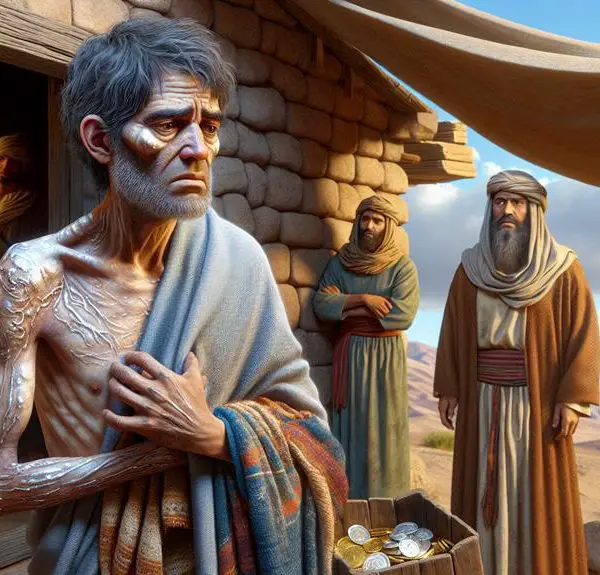Trinity glimpses in the Bible spark deep dives into divine mysteries—discover where these moments lead.

Where Is Trinity Found in the Bible
Imagine you're exploring the Baptism of Jesus in the New Testament, where the presence of the Holy Spirit, the voice of God the Father, and the Son being baptized converge in a singular, divine moment. This scene often sparks debates among scholars and believers alike about the concept of the Trinity in the Bible.
As you consider the various interpretations, you'll find that this is just one of many passages that theologians point to when discussing the triune nature of God. The question then becomes, how do these instances weave together to form the doctrine of the Trinity, and what implications does this have for your understanding of scripture?
Let's explore further and uncover the layers of meaning behind these pivotal moments.
Key Takeaways
- The concept of the Trinity is alluded to in the Old Testament and explicitly illustrated in the New Testament.
- Trinitarian themes are central in Christian missions, as seen in Jesus' baptism and directive to baptize in the name of the Trinity.
- Apostolic greetings and Paul's epistles reflect nuanced Trinitarian theology, emphasizing the cooperative roles within the Godhead.
- Specific Scripture verses in Paul's Epistles and the Book of Revelation provide profound insights into the Trinitarian framework.
Old Testament Allusions
Often, the concept of the Trinity is subtly hinted at in the Old Testament through various passages and narratives that scholars have analyzed over centuries. You'll find that these references, while not explicitly outlining the Trinity as understood in Christian doctrine, provide a foundation for later theological interpretations.
In the Genesis creation narrative, for instance, you encounter the Spirit of God hovering over the waters, a phrase that has intrigued scholars for generations. This depiction suggests a multi-faceted God involved in the creation process. The use of 'us' and 'our' when God says, 'Let us make man in our image, after our likeness,' further fuels debates about the plural nature of God, hinting at a complex unity that many scholars associate with the Trinity concept.
Another compelling example is found in the story of Abraham's visitors. Abraham receives three men, whom he treats with great honor and hospitality. This episode is often interpreted as Abraham hosting the Lord, yet the presence of three visitors has led some scholars to suggest a Trinitarian symbolism. The narrative doesn't explicitly identify the visitors as the Trinity, but the triadic appearance has been seen as an allusion to the complex nature of God's revelation to humanity.
These Old Testament allusions aren't direct confirmations of the Trinity but serve as foundational elements that later Christian theology would build upon. They invite you to ponder the multifaceted nature of God, even before the full revelation of the Trinity in the New Testament.
Baptism of Jesus
In the narrative of Jesus' baptism, as recorded in the New Testament, all three persons of the Trinity are distinctly present and active, offering a clear instance of Trinitarian interaction within the Christian faith. This event encapsulates the essence of the Trinity through the actions and symbols of the Heavenly voice, the descending dove, and Jesus himself being baptized.
At this moment, the heavens open, and the Spirit of God descends like a dove, alighting on Jesus. This visual representation of the Spirit is pivotal, symbolizing the divine approval and empowerment of Jesus for his ministry. Concurrently, a Heavenly voice declares, "This is my Son, whom I love; with him, I am well pleased." This voice from heaven is understood to be God the Father's, affirming Jesus' sonship and divine mission.
The baptism of Jesus serves as a foundational episode for Trinitarian theology, illustrating the distinct yet united presence and work of the Father, the Son, and the Holy Spirit. The following table summarizes the Trinitarian elements present at Jesus' baptism:
Person of the Trinity |
Symbol or Action |
Significance |
|---|---|---|
The Father |
Heavenly voice |
Affirms Jesus' divine sonship and mission |
The Son (Jesus) |
Being baptized |
Marks the commencement of his public ministry |
The Holy Spirit |
Descending like a dove |
Symbolizes divine approval and empowerment |
This event not only marks the beginning of Jesus' ministry but also provides a vivid illustration of the Trinity's interconnectedness and mutual involvement in the salvific work of Christianity.
The Great Commission

Building on the foundational episode of Jesus' baptism, the Great Commission further reveals the Trinitarian nature of Christian mission and discipleship. In this pivotal moment, recorded in Matthew 28:19-20, Jesus directs His followers to 'go and make disciples of all nations, baptizing them in the name of the Father and of the Son and of the Holy Spirit.' This mission mandate encapsulates the essence of Christian outreach, embedding the Trinitarian formula as central to the act of disciple making.
Analyzing this passage, you'll recognize the intricate relationship between the members of the Trinity and the Christian mandate. The directive to baptize in the name of the Father, Son, and Holy Spirit underscores the unity and distinctiveness of each Person within the Godhead, a cornerstone of Trinitarian theology. This command not only authorizes but also compels the believer to engage in a mission that reflects the communal and relational nature of the Trinity itself.
Furthermore, the Great Commission provides a framework through which the disciple-making process is to be understood and executed. It's not merely about expanding the number of believers but about nurturing a deep, transformative relationship with God as revealed in Jesus Christ and empowered by the Holy Spirit. This mission isn't just about teaching observance of commands but about cultivating an understanding of God's redemptive work throughout history, culminating in the life, death, and resurrection of Jesus.
In essence, the Great Commission intricately weaves the Trinitarian concept into the fabric of Christian discipleship and mission, emphasizing a holistic approach to faith that mirrors the relational dynamics within the Godhead.
Apostolic Greetings
Analyzing apostolic greetings reveals a nuanced reflection of Trinitarian theology, as these salutations frequently encapsulate the early Christian understanding of the relationship between the Father, Son, and Holy Spirit. When you delve into these greetings, you're not just encountering polite introductions or customary pleasantries. Instead, you're witnessing a profound theological foundation being laid, one that subtly but significantly acknowledges the Trinity.
A grace introduction in these greetings often serves as a direct channel of divine favor, invoking the unmerited mercy that flows from God through Christ to the believers. This isn't merely a wish for goodwill; it's a theological assertion, affirming that grace originates from the Father and is actualized through the Son, hinting at the cooperative and distinct roles within the Godhead.
Similarly, peaceful salutations aren't just hopes for tranquility. They're rooted in the peace that Christ Himself proclaimed and personified, a peace that surpasses understanding and is made available to believers through the indwelling of the Holy Spirit. This peace is a hallmark of Christian identity, offered by the Father, procured by the Son's sacrifice, and applied by the Spirit's presence.
What's remarkable about these apostolic greetings is their ability to communicate profound truths about the Trinity in a concise manner. They're not just formulaic openings but are imbued with theological depth, capturing the essence of the early Church's understanding of God's triune nature. Through grace introductions and peaceful salutations, the complex doctrine of the Trinity is woven into the fabric of Christian communication, reflecting a deeply ingrained awareness of the interconnectedness of the Father, Son, and Holy Spirit.
Pauline Epistles

Delving into the Pauline Epistles, you'll uncover layers of Trinitarian theology intricately woven through the texts, showcasing Paul's profound understanding of the divine relationship between the Father, Son, and Holy Spirit. Paul's letters are rich with references that not only affirm the existence of the Trinity but also highlight its operational dynamics within the Christian life, particularly through spiritual gifts and the supremacy of Christ.
Paul articulates the diversity and unity of spiritual gifts in the context of the Trinity, emphasizing that these gifts, though varied, originate from the same divine source. This underscores a fundamental aspect of Trinitarian theology: unity in diversity. Moreover, Christ's supremacy is a recurring theme, asserting Jesus' divine nature and his integral role within the Trinitarian relationship.
Reference |
Trinitarian Insight |
|---|---|
1 Corinthians 12:4-6 |
Spiritual gifts are attributed to the same God, specifying different activities but the same God who empowers them all. |
Ephesians 1:3-14 |
Paul presents an elaborate Trinitarian formula, blessing the Father for choosing us, lauding the Son for redemption, and acknowledging the Holy Spirit's seal of inheritance. |
Colossians 1:15-20 |
Asserts Christ's supremacy and role in creation, emphasizing his preeminence and reconciliation of all things through him. |
2 Corinthians 13:14 |
Offers a benediction that beautifully encapsulates the Trinity, wishing the grace of Jesus, the love of God, and the fellowship of the Holy Spirit. |
These passages, among others in the Pauline Epistles, articulate a theological framework that is unambiguously Trinitarian, reinforcing the interconnectedness of the Father, Son, and Holy Spirit in the Christian faith.
Revelations' Insights
You'll find that the Book of Revelation offers unique perspectives on the Trinity through symbolic representations and explorations of divine unity.
This segment of scripture provides a rich tapestry for understanding the interconnectedness of the Father, Son, and Holy Spirit.
Analyzing these elements allows you to grasp the complexity and unity of the Trinity in a prophetic context.
Symbolic Trinity Representations
Exploring the Book of Revelation, one finds symbolic representations of the Trinity that offer profound insights into the nature of God as depicted in Christian theology. This analysis delves into the intricate imagery and metaphors that articulate the triune nature of God without directly invoking the concept.
- The Creation narrative in Revelation echoes the Genesis account, subtly hinting at a triune creator.
- Wisdom personified in the text can be interpreted as a reflection of the divine Logos, aligning with the notion of the Son.
- Visions of the throne room symbolize God's sovereignty, encapsulating the Father's authority.
- The presence of the Lamb and the seven spirits, often linked to the Holy Spirit, completes this symbolic trio.
These elements collectively form a mosaic, offering a glimpse into the Trinity's interconnected roles within the Christian faith.
Divine Unity Explored
In the Book of Revelation, the concept of divine unity is intricately woven into the narrative, offering a nuanced perspective on the interconnectedness of the Trinity within Christian theology. This text, dense with symbolic imagery, showcases angelic interactions as a testament to the seamless operation of the Father, Son, and Holy Spirit in the orchestration of the cosmos.
The creation narrative, revisited through the apocalyptic lens, underscores this unity further by highlighting the collaborative divine effort in the establishment and sustenance of life. Through careful analysis, you'll discern that these elements collectively point towards a sophisticated understanding of divine unity, challenging and enriching the traditional interpretations of the Trinity's role and presence in the biblical canon.
Frequently Asked Questions
How Do Non-Christian Religions Interpret the Concept of the Trinity as Presented in the Bible?
You're diving into how non-Christian faiths view the Bible's Trinity concept, a topic ripe for interfaith dialogues and comparative theology analysis.
Many see it through their theological lenses, often contrasting with monotheistic views or interpreting it metaphorically.
This scholarly exploration fosters a deeper understanding across beliefs, highlighting commonalities and differences without assuming a universal perspective.
It's a nuanced conversation that enriches both interfaith understanding and personal beliefs.
Are There Any Historical Documents or Early Christian Writings Outside of the Bible That Provide Additional Insight Into the Development of the Trinity Doctrine?
Yes, there are historical documents and writings by early theologians that shed light on the Trinity origins. These texts provide a deeper understanding of how the doctrine developed over time.
You'll find that figures like Tertullian and Augustine played pivotal roles in articulating the concept. Their works, along with various councils and creeds, contributed significantly to the theological foundations and nuances of the Trinity doctrine outside the biblical text.
How Has the Understanding and Interpretation of the Trinity Evolved Within Christian Denominations Over the Centuries?
You've journeyed through the annals of Christian history, witnessing the evolution of the Trinity's understanding. Picture heated council debates, where theologians passionately argue, and the meticulous crafting of Creeds.
Over centuries, these discussions have shaped how different denominations interpret the Trinity. From the early church's struggle to articulate this complex doctrine to modern interpretations, your exploration reveals a rich tapestry of belief, continuously woven by faith, intellect, and divine mystery.
What Are Some Common Misconceptions or Misunderstandings About the Trinity Among Christians and Non-Christians Alike?
You might've heard some misconceptions about the Trinity, like it's purely symbolic or lacks spiritual depth. Yet, these misunderstandings overlook the rich Trinity symbolism and its profound spiritual implications.
Many think it's a concept too complex for practical faith, while others see it as conflicting with monotheism. Analyzing these views, it's clear that misconceptions stem from a lack of deep engagement with the theological intricacies surrounding the Trinity.
Can the Concept of the Trinity Be Reconciled With the Strict Monotheism Emphasized in the Old Testament?
Yes, you can reconcile the Trinity with the Old Testament's strict monotheism. The key lies in understanding monotheistic origins and conceptual unity.
Scholars argue that the Trinity doesn't contradict monotheism but deepens our understanding of God's nature. By examining biblical texts and theological interpretations, you'll find that the concept of a triune God aligns with the Old Testament's emphasis on a single, unified deity, thus maintaining a consistent monotheistic thread throughout the scriptures.
Conclusion
In conclusion, you've navigated through the biblical landscape, uncovering the concept of the Trinity from Old Testament allusions to Revelations' insights.
The baptism of Jesus, the Great Commission, apostolic greetings, and Pauline Epistles serve as cornerstones. Imagine them as pieces of a mosaic, each contributing to the holistic picture of the Trinity.
This exploration, grounded in analytical and scholarly rigor, affirms the Trinity's nuanced presence across the biblical narrative, enriching your understanding of this foundational Christian doctrine.



Sign up